Nurses Narratives - Matron A Kellett - Part 5

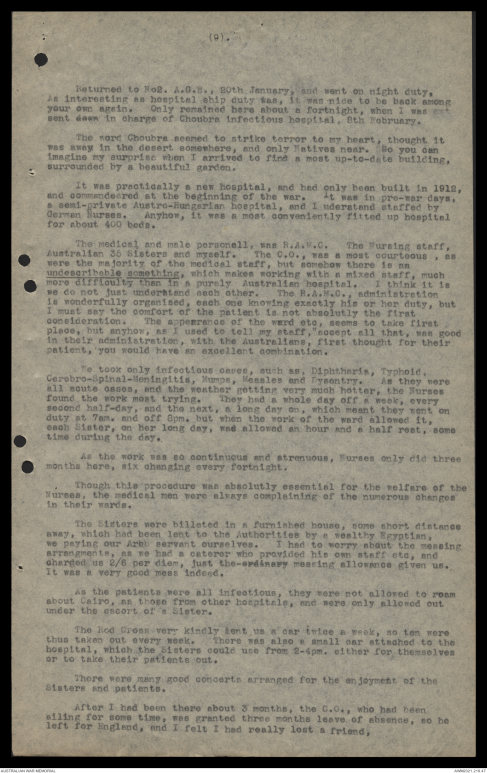
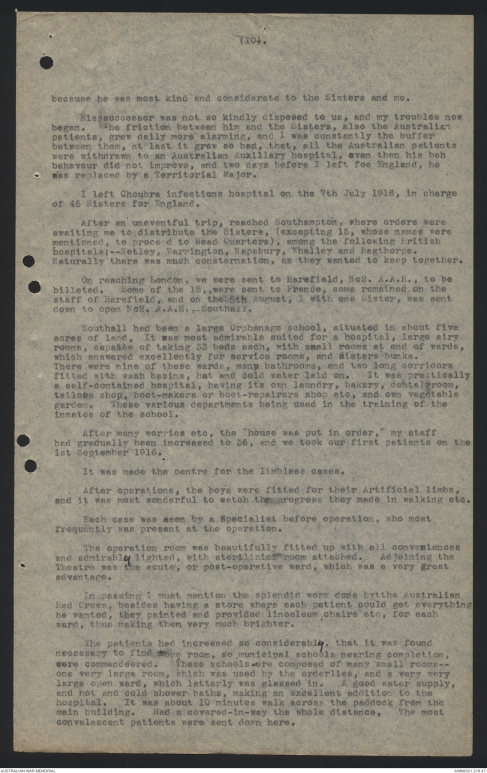
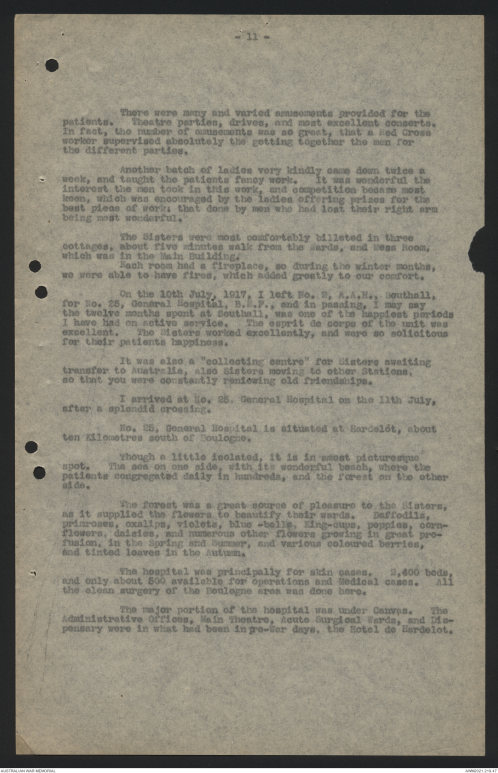
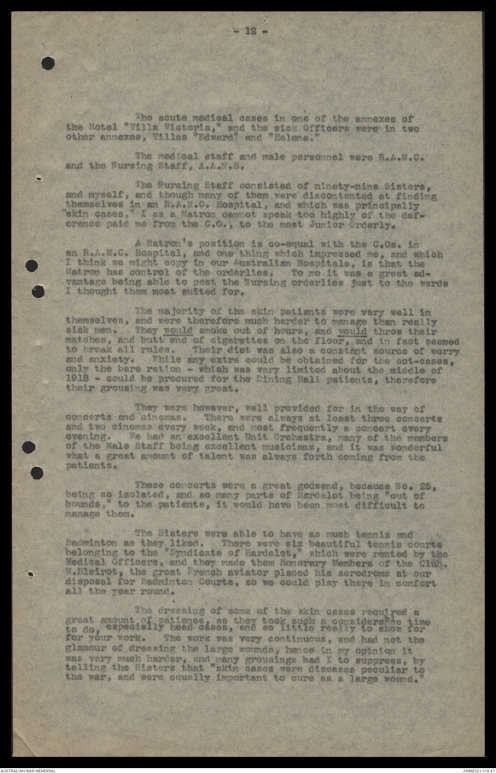
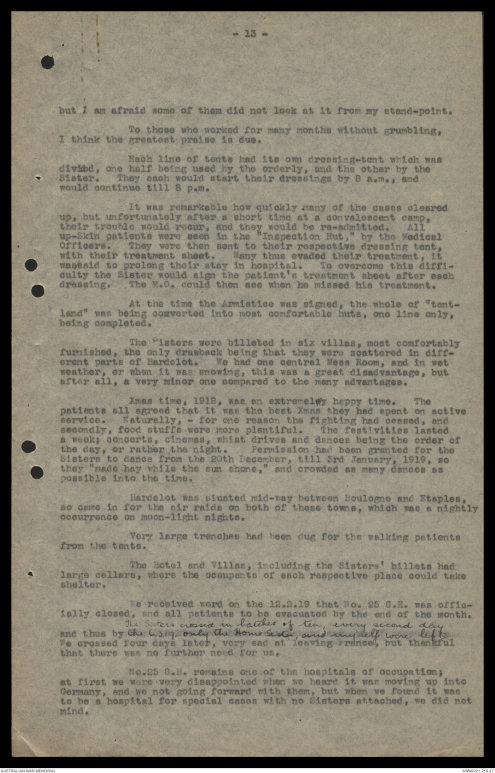
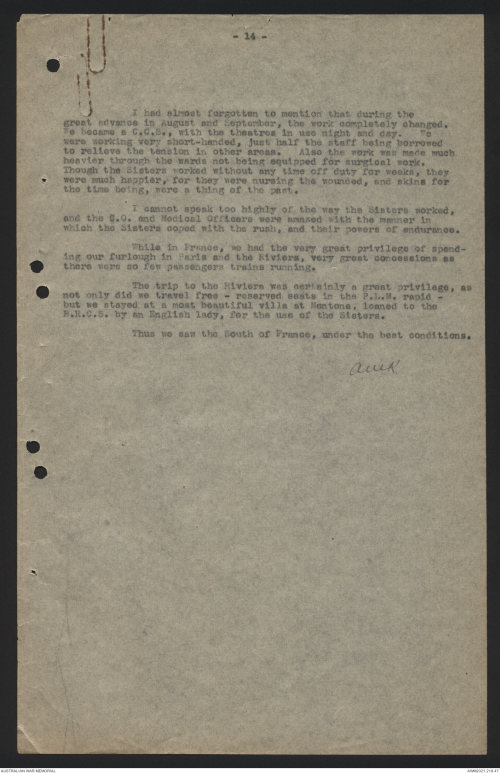
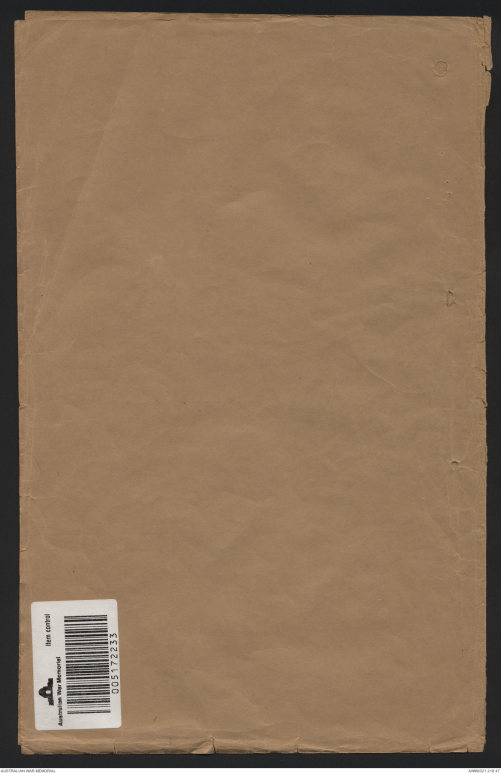
(8.)
docked, and needles to say we made " hay while the sun shone . "
We returned to the ship on the 11th November11915 . She had been
thoroughly painted and cleaned , and electric heaters put in our cabins,
which added greatly to our comfort. She had aboard, the Medical staff,
male personell and equipment of the 29th British General hospital, and
set sail with them for Salonica. Had an extremely rough trip , for
two days were "hove to," crossing the bay. The waves were breaking
over the bridge, the Captain saying it was the roughest trip he had had
for nine years.
Reached Salonica on the 25th Nov, too late to enter harbour, the
boom was down, so anchored outside for the night . Bitterly cold.
Olymplius and the surrounding mountains were covered with snow, as was
the town. The air was much colder than the water, that as it struck
it, a vaper arose. It was a grand sight, the whole harbour was like
a steaming cauldron. So thick was this mist, that it was with great
difficulty that the outline of ships, a very short distance away, could
be descerned. I have never experienced such bitter, bitter cold, in
my life.
We remained in the harbour for about twelve days,,before orders
came for the 29th Hospital to disembark. We then filled up with
Trench feet, and frost-bitten asses. The stories we were told of their
sufferings in the blizzard , were heart-breaking, but when they reached
the ship, they were perfectly happy, though there were many amputations
of feet, toes and fingers. I have never seen such bad cases of Trench
feet as these.
We left Salonica on the 5th December 1915, reaching Alexandria
on the 10th Dec. Disembarked our patients, and then made a mad rush
for our mail, the first we had received for three months, one of the
great drawbacks of transport duty.
Had two days in Alexandria, and filled up with convalescent patients
and set sail for on the 12th Dec, for England, only got a short distance
out, when our engines broke down, and back to port we had to put.
It was two days before they were repaired and in order to sail. Off
we went again on the 14th Dec. The medicaloOfficers and crew were
most anxious to reach England for Xmas Day.
I was again on night duty, very rough indeed, nothing special to
mention about this trip, except all hands were hard at work for a few
days, making up parcels etc, for Xmas presents for the patients.
We had Xmas dinner in Southampton water, and an excellent dinner
it was, the Chef excelling himself.
The ship provided a special dinner for the boys, also a present
for each, and a concert during the afternoon, so altogether, they had a
very happy time.
Reached Southampton early Boxing day morning, patients disembarked
and we were free till 1st January 1916.
After a great amount of trouble our Matron, Miss. Woollen, got
our warrants, and we left for London, returning on the morning of the
1st Jan, to find we were not sailing until the 4th, but we put the time
in very nicely by visiting the surrounding places of interest.
On the 4th Jan, embarked Indians and Indian medical service
men, but as they had their own orderlies etc, to look after them,
we had nothing to do for them, it was therefore a very uninteresting
trip. Reached Alexandria on the 17th Jan, and sent here I left the
ship, joining my own Unit.
(9).
Returned to No2. A.G.H., 20th January, and went on night duty.
As interesting as hospital ship duty was, it was nice to be back among
your own again. Only remained here about a fortnight, when I was
sent down in charge of Choubra infectious hospital, 8th February.
The word Choubra seemed to strike terror to my heart, thought it
was away in the desert somewhere, and only Natives near. So you can
imagine my surprise when I arrived to find a most up-to-date building,
surrounded by a beautiful garden.
It was practically a new hospital, and had only been built in 1912,
and commandeered at the beginning of the war. It was in pre-war days,
a semi-private Austro-Hungarian hospital, and I uderstand staffed by
German Nurses. Anyhow, it was a most conveniently fitted up hospital
for about 400 beds.
The medical and male personell, was R.A.M.C. The Nursing staff,
Australian 35 Sisters and myself. The C.O., was a most courteous , as
were the majority of the medical staff, but somehow there is an
undescribable something, which makes working with a mixed staff, much
more difficulty than in a purely Australian hospital. I think it is
we do not just understand each other. The R.A.M.C., administration
is wonderfully organised, each one knowing exactly his or her duty, but
I must say the comfort of the patient is not absolutly the first
consideration. The appearance of the ward etc, seems to take first
place, but anyhow, as I used to tell my staff, "accept all that, was good
in their administration, with the Australians, first thought for their
patient, you would have an excellent combination.
We took only infectious cases, such as, Diphtheria, Typhoid,
Cerebro-Spinal-Meningitis, Mumps, Measles and Dysentry. As they were
all acute cases, and the weather getting very much hotter, the Nurses
found the work most trying. They had a whole day off a week, every
second half-day, and the next, a long day on, which meant they went on
duty at 7am. and off 8pm. but when the work of the ward allowed it,
each Sister, on her long day, was allowed an hour and a half rest, some
time during the day.
As the work was so continuous and strenuous, Nurses only did three
months here, six changing every fortnight.
Though this procedure was absolutly essential for the welfare of the
Nurses, the medical men were always complaining of the numerous changes
in their wards.
The Sisters were billeted in a furnished house, some short distance
away, which had been lent to the Authorities by a wealthy Egyptian,
we paying our Arab servant ourselves. I had to worry about the messing
arrangments, as we had a caterer who had provided his own staff etc, and
charged us 2/6 per diem, just the-ordinary messing allowance given us.
It was a very good mess indeed.
As the patients were all infectious, they were not allowed to roam
about Cairo, as those from other hospitals, and were only allowed out
under the escort of a Sister.
The Red Cross very kindly lent us a car twice a week, so ten were
thus taken out every week. There was also a small car attached to the
hospital, which the Sisters could use from 2-4pm. either for themselves
or to take their patients out.
There were many good concerts arranged for the enjoyment of the
Sisters and patients.
After I had been there about 3 months, the C.O., who had been
ailing for some time, was granted three months leave of absence, so he
left for England, and I felt I had really lost a friend,
(10).
because he was most kind and considerate to the Sisters and me.
His successor was not so kindly disposed to us, and my troubles now
began. The friction between him and the Sisters, also the Australian
patients, grew daily more alarming, and I was constantly the buffer
between them, at last it grew so bad, that, all the Australian patients
were withdrawn to an Australian Auxillary hospital, even then his beh
behavour did not improve, and two days before I left foe England, he
was replaced by a Territorial Major.
I left Choubra infections hospital on the 7th July 1916, in charge
of 45 Sisters for England.
After an uneventful trip, reached Southampton, where orders were
awaiting me to distribute the Sisters, (excepting 15, whose names were
mentioned, to proceed to Head Quarters), among the following British
hospitals:--Netley, Warrington, Napsbury, Thalley and Bagthorpe.
Naturally there was much consternation, as they wanted to keep together.
On reaching London, we were sent to Harefield, No.2. A.A.H., to be
billeted. Some of the 15.,were sent to France, some remained on the
staff of Harefield, and on the 5th August, I with one Sister, was sent
down to open No2. A.A.H., Southall.
Southall had been a large Orphanage school, situated in about five
acres of land. It was most admirable suited for a hospital, large airy
rooms, capable of taking 33 beds each, with small rooms at end of wards,
which answered excellently for service rooms, and Sisters bunks.
There were nine of these wards, many bathrooms, and two long corridors
fitted with wash basins, hot and cold water laid on. It was practically
a self-contained hospital, having its own laundry, bakery, dental rooms,
tailors shop, boot-makers or boot-repairers shop etc, and own vegetable
garden. These various departments being used in the training of the
inmates of the school.
After many worries etc, the "house was put in order", my staff
had gradually been increased to 36, and we took our first patients on the
1st September 1916.
It was made the centre for the limbless cases.
After operations , the boys were fitted for their Artificial limbs,
and it was most wonderful to watch the progress they made in walking etc.
Each case was seen by a Specialist before operation, who most
frequently was present at the operation.
The operation room was beautifully fitted up with all conveniences
and admirably lighted, with sterilizing room attached. Adjoining the
Theatre was the acute, or post-operative ward, which was a very great
advantage.
In passing I must mention the splendid work done by the Australian
Red Cross, besides having a store where each patient could get everything
he wanted, they painted and provided linoeleum, chairs etc, for each
ward, thus making them very much brighter.
The patients had increased so considerably, that it was found
necessary to find more room, so municipal schools nearing completion,
were commandeered. These schools ere composed of many small rooms --
one very large room, which was used by the orderlies, and a very very
large open ward, which latterly was glassed in. A good water supply,
and hot and cold shower baths, making excellent addition to the
hospital. It was about 10 minutes walk across the paddock from the
main building. Had a covered-in-way the whole distance. The most
convalescent patients were sent down here.
-11-
There were many varied amusements provided for the
patients. Theatre parties, drives, and most excellent concerts.
In fact, the number of amusements was so great, that a Red Cross
worker supervised absolutely the getting together the men for
the different parties.
Another batch of ladies very kindly came down twice a
week, and taught the patients fancy work. It was wonderful the
interest the men took in this work, and competition became most
keen, which was encouraged by the ladies offering prizes for the
best piece of work: that done by men who had lost their right arm
being most wonderful.
The Sisters were most comfortably billeted in three
cottages, about five minutes walk from the Wards, and Mess Room,
which was in the Main Building.
Each room had a fireplace, so during the winter months
we were able to have fires, which added greatly to our comfort.
On the 10th July, 1917, I left No. 2 A.A.H., Southall
for no, 25, General Hospital, B.F.F., and in passing, I may say
the twelve months spent at Southall, was one of the happiest periods
I have had on active service. The esprit de corps of the unit was
excellent. The Sisters worked excellently, and were so solicitous
for their patients happiness.
It was also a "collecting centre" for Sisters awaiting
transfer to Australia, also Sisters moving to other Stations,
so that you were constantly renewing old friendships.
I arrived at No. 25, General Hospital on the 11th July,
after a splendid crossing.
No. 25, General Hospital is situated at Hardelot, about
10 kilometres south of Boulogne.
Yhough a little isolated, it is in amost picturesque
spot. The sea on one side, with its wonderful beach, where the
patients congregated daily in hundreds, and the forest on the other
side.
The forest was a great source of pleasure to the Sisters,
as it supplied the flowers to beautify their wards. Daffodils,
primroses, oxalips, violets, blue- bells, King-cups, poppies, corn-
flowers, daisies, and numerous other flowers growing in great prof-
usion, in the Spring and Summer, and various coloured berries,
and tinted leave in the Autumn.
The hospital was principally for skin cases. 2,400 beds,
and only about 500 available for operations and Medical cases. All
the clean surgery of the Boulogne area was done here.
This major portion of the hospital was under Canvas. The
Administrative Offices, Main Theatre, Acute Surgical Wards, and Dis-
pensary were in what had been in pre-War days, the Hotel de Hardelot.
-12-
The acute medical cases in one of the annexes of
the Hotel "Villa Victoria," and the sick Officers were in two
other annexes, Villas "Edward " and "Helene."
The medical staff and male personnel were R.A.M.C.
and the Nursing Staff, A.A.N.S.
The Nursing Staff consisted of ninety-nine Sisters,
and myself, and though many of them were discontented at finding
themselves in an R.A.M.C Hospital, and which was principally
"skin cases," I as a Matron cannot speak too highly of the def-
erence paid to me from the C.O., to the most Junior Orderly.
A Matron's position is co-equal with the C.Os. in
an R.A.M.C Hospital, and one thing which impressed me, and which
I think we might copy in our Australian Hospitals, is that the
Matron has control of the orderlies. To me it was a great ad-
vantage being able to post the Nursing orderlies just to the wards
I thought them most suited for.
The majority of the skin patients were very well in
themselves, and were therefore much harder to manage than really
sick men. They would smoke out of hours, and would throw their
matches , and butt end of cigarettes on the floor, and in fact seemed
to break all rules. Their diet was also a constant source of worry
and anxiety. While any extra could be obtained for the cot-cases,
only the bare ration - which was very limited about the middle of
1918 - could be procured for the Dining Hall patients, therefore
their grousing was very great.
They were however, well provided for in the way of
concerts and cinemas. There were always at least three concerts
and two cinemas every week, and most frequently a concert every
evening. We had an excellent Unit Orchestra, many of the members
of the Male Staff being excellent musicians, and it was wonderful
what a great amount of talent was always forth coming from the
patients.
These concerts were a great godsend, because No. 25,
being so isolated, and so many parts of Hardelot being "out of
bounds," to the patients, it would have been most difficult to
manage them.
The Sisters were able to have as much tennis and
Badminton as they liked. There were six beautiful tennis courts
belonging to the "Syndicate of Hardelot," which were rented by the
Medical Officers, and they made them Honorary Members of the Club.
M.Bleirot, the great French aviator placed his aerodrome at our
disposal for the Badminton Courts, so we could play there in comfort
all the year round.
The dressing of some of the skin cases required a
great amount of patience, as they took such considerable time
to do, especially head cases, and so little really to show for
for your work. The work was very continuous, and had not the
glamour of dressing large wounds, hence in my opinion it
was very much harder, and many grousings had I to supress, by
telling the Sisters that "skin cases were diseases peculiar to
the war, and were equally important to cure as a large wound."
-13-
but I am afraid some of them did not look at it from my stand-point.
To those who worked for many months without grumbling,
I think the greatest praise is due.
Each line of tents had its own dressing-tent which was
divided, one half being used by the orderly, and the other by the
Sister. They each would start their dressings by 8 a.m., and
would continue till 8 p.m.
It was remarkable how quickly many of the cases cleared
up, but unfortunately after a short time at a convalescent camp,
their trouble would recur, and they would be re-admitted. All
up-Skin patients were seen in the "Inspection Hut", by the Medical
Officers. They were then sent to their respective dressing tent,
with their treatment sheet. Many thus evaded their treatment, it
was/said to prolong their stay in hospital. To overcome this diffi-
culty the Sister would sign the patient's treatment sheet after each
dressing. The C.O. could then see when he missed his treatment.
At the time the Armistice was signed, the whole of "tent-
land" was being converted into most comfortable huts, one line only,
being completed.
The Sisters were billeted in six villas, most comfortably
furnished, the only drawback being that they were scattered in diff-
erent parts of Hardelot. We had one central Mess Room, and in wet
weather, or when it was snowing, this was a great disadvantage, but
after all, a very minor one compared to the many advantages.
Xmas time, 1918, was an extremely happy time. The
patients all agreed that it was the best Xmas they had spent on active
service. Naturally, - for one reason the fighting has ceased, and
secondly, food stuffs were more plentiful. The festivities lasted
a week; concerts, cinemas, whist drives and dances being the order of
the day, or rather the night. Permission had been granted for the
Sisters to dance from the 20th December, till 3rd January, 1919, so
they "made hay while the sun shone," and crowded as many dances as
possible into the time.
Hardelot was situated mid-way between Boulogne and Etaples,
so came in for the air raids on both of these towns, which was a nightly
occurrence on moon-light nights.
Very large trenches had been dug for the walking patients
from the tents.
The Hotel and Villas, including the Sisters' billets had
large cellars, where the occupants of each respective place could take
shelter.
We received word on the 12.2.19 that No. 25 O.H. was offic-
ially closed, and all patients to be evacuated by the end of the month.
The Sisters crossed in batches of ten, every second day
and thus by the 6.3.19 only the Home Sister, and myself were left.
We crossed four days later, very sad at leaving France, but thankful
that there was no further need for us.
No. 25 O.H. remains one of the hospitals of occupation;
at first we were very disappointed when we heard it was moving up into
Germany, and we not going forward with them, but when we found it was
to be a hospital for special cases with no Sisters attached, we did not
mind.
- 14 -
I had almost forgotten to mention that during the
great advance in August and September, the work completely changed.
We became a C.G.S., with the theatres in use night and day. We
were working very short-handed, just half the staff being borrowed
to relieve the tension in other areas. Also the work was made much
heavier through the wards not being equipped for surgical work.
Though the Sisters worked without any time off duty for weeks, they
were much happier, for they were nursing the wounded, and skins for
the time being, were a thing of the past.
I cannot speak too highly of the way the Sisters worked,
and the C.O. and Medical Officers were amazed with the manner in
which the Sisters coped with the rush, and their powers of endurance.
While in France, we had the very great privilege of spend-
ing our furlough in Paris and the Riviera, very great concessions as
there were so few passengers trains running.
The trip to the Riviera was certainly a great privilege, as
not only did we travel free - reserved seats in the P.L.M rapid -
but we stayed at a most beautiful villa at Mentone, loaned to the
B.R.C.S. by an English lady, for the use of the Sisters.
Thus we saw the South of France, under the best conditions.
AK.
[Blank page with AWM sticker with bar code]
005172233
 Sam scott
Sam scottThis transcription item is now locked to you for editing. To release the lock either Save your changes or Cancel.
This lock will be automatically released after 60 minutes of inactivity.